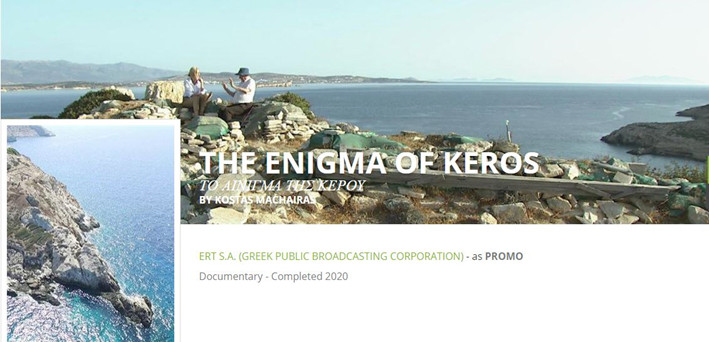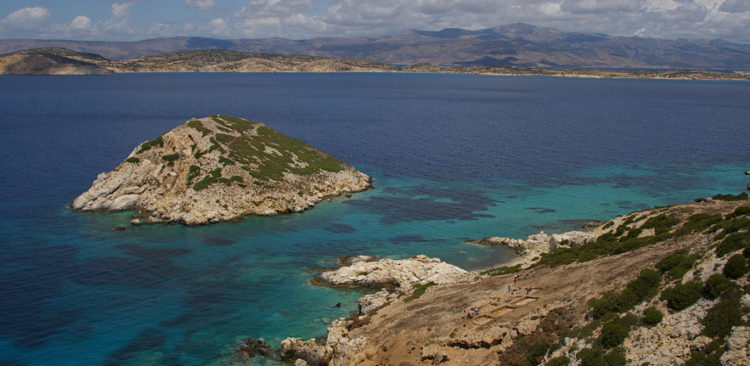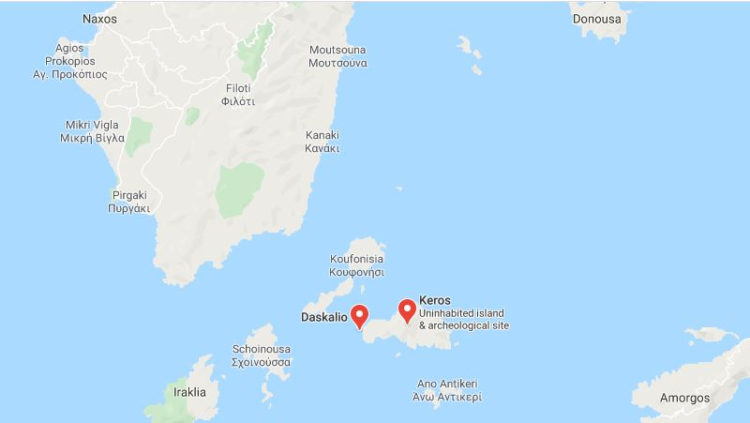“The Enigma of Keros” Colin Renfrew’s amazing discoveries in the Greek Cyclades
A video about Professor Lord Colin Renfrew, and his important work on Keros – posted here on his birthday, 25 July.

The hillside town of Kommos, in Crete, was originally settled in the Late Neolithic through the Early Minoan I period, approximately 3,500 – 2900 B.C. and is located on a north-south slope of land against the Libyan Sea to its immediate west. The people of this Minoan culture developed an affinity with the seas surrounding their island. In the Cycladic islands to the north of Crete and west of Anatolia (today part of western Turkey), something amazing was developing during the same time period in the form of a distinct Cycladic culture.

The new video posted on You Tube, contains conversations, subtitles and narrations in English and Greek , focuses on the seminal archaeological investigations of one of the world’s leading archaeologists, Colin Renfrew (born 25 July 1937). During my long career in Colorado a colleague of mine, archaeologist Tod McMahon, told me how he had studied Colin Renfrew publications in college. I was then working on conserving and developing significant archaeological sites in the four corners area of the United States (Colorado, New Mexico, Arizona and Utah) through the Colorado State Historic Preservation Office (SHPO). I had developed an interest in Minoan culture as a consequence of my Greek-American heritage and had traveled to Greece several times since my teenage years. Increasingly, my interest in the Bronze Age period there led me to Spyridon Marinatos’ excavations on Thera (aka Santorini). The excavation and conservation work being done there familiarized me with Joseph Shaw’s publications, through the Archaeological Institute of America’s Journal.
Shaw had dissected a Minoan roof from the Akrotiri site on Thera, which predated Colorado’s Ancestral Puebloan (aka Anasazi) cliff dwellings and their other exposed sites. The masonry wall structures, however, are very similar at both sites on different continents, and roofs are an extremely rare find, so I was amazed at Shaw’s findings, analysis and descriptions. While I was working on plans to stabilize the ruins in Colorado, efforts on Bronze Age Cretan sites were employing similar means and methods. My interest in ruin stabilization crossed over into the pre-histories of both cultures
Colin Renfrew’s publications are not only about the Eastern Mediterranean and they were held in the highest regard, McMahon told me. Finding a Colorado archaeological specialist familiar with Renfrew’s Cycladic experience related to our work in Colorado confirmed the European-American commonality of both archaeological theory and the focus of my own cultural resource management. Soon thereafter I initiated meetings with Marinatos’ successor at Akrotiri, Professor Doumas – also featured in the film – and Joseph Shaw on Crete. I returned to my work in Colorado, established the Kommos Conservancy with Joseph and Maria Shaw as principal officers and began to document and promote conservation necessities and public outreach about the Kommos site.

I was delighted to find the recently released (July 20, 2020) film by Kostas Machairas “The Enigma of Keros”. The excavations at Daskalio (directed by Colin Renfrew and Michael Boyd of the McDonald Institute, University of Cambridge) have completely transformed our understanding of what was previously seen as a Cycladic enigma. The now uninhabited island of Keros, in the Cyclades, was the site of the world’s earliest maritime sanctuary in the Early Bronze Age, and a thriving center for metal production, providing much evidence for all crucial developments in architecture. This documentary features both Renfrew and Boyd’s work as it shadows their excavation crew’s activity on the Cycladic island. This is an important educational enhancement to their scholarship, manifest in publication and presentations. The final publication of the Kommos excavations was published in 2017, edited by Professors Emeriti Joseph and Maria Shaw and written by Aegean scholar, Dartmouth Professor Emeritus Jeremy Rutter. The multitude of inter-disciplinary analyses of Kommos archaeological finds and their relevance is available to scholars through the University of Toronto. Also, a delightfully readable handbook of the site features, with anecdotes from Professor Joseph Shaw, is available on line and through bookstores. As public interpretation continues to move forward, a video should also be made to highlight the unique seaport’s features and promote its conservation. The project now has the support also of Kommos excavation alumnus Professor James Wright, the former Director of the American School of Classical Studies at Athens. However, the pandemic has delayed planned stabilization treatments and the presentation previously scheduled to be held at the new Museum of the Mesara, not far from the Kommos site. While we wait for Wright’s ‘Kommos Master Plan’ update presentation, we may enjoy the video on Professor Renfrew’s work on the Keros excavation.
You can follow us on Twitter (@KommosAP) or join us on Facebook (Kommos Conservancy).
“Μπορείτε να μας ακολουθήσετε στο Twitter (@KommosAP) ή στο Facebook (Kommos Conservancy).”

Leave a Reply
You must be logged in to post a comment.